#Roman Republican art
Text

Roman silver coin minted in 55 BCE, during Julius Caesar's campaigns in Gaul, by Publius Fonteius Capito, one of the tresviri monetales (mint officials) for that year. On the obverse, the helmeted head of the war god Mars, with a small representation of a tropaeum (trophy) behind him. On the reverse, a Roman horseman rides down two enemy soldiers, identified by their helmets and shields as Gauls.
#classics#tagamemnon#history#ancient history#Ancient Rome#Roman Republic#Roman history#art#art history#ancient art#Roman art#Ancient Roman art#Roman Republican art#artifacts#artefacts#coins#ancient coins#Roman coins#Ancient Roman coins#numismatics#ancient numismatics#Roman numismatics
108 notes
·
View notes
Text
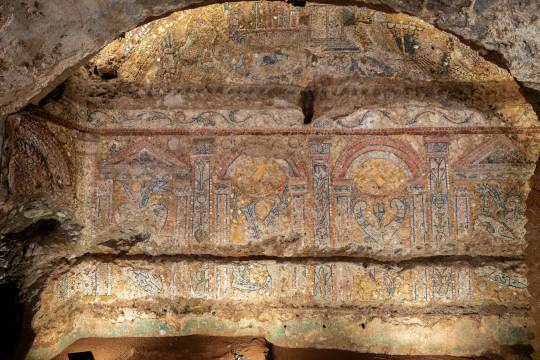
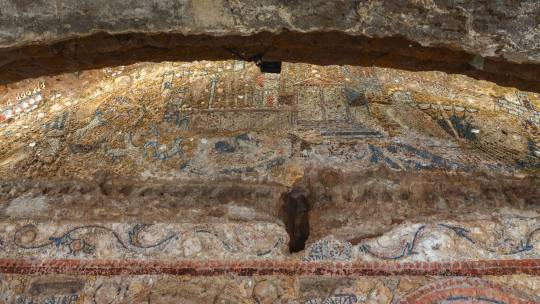
‘Incredible’ Mosaics Were Found in an Ancient Luxury Home in Rome
Italy’s Culture Minister Gennaro Sangiuliano has called the works “an authentic treasure.”
Researchers working in the Archaeological Park of the Colosseum in Rome have shared their discovery of luxurious mosaic-tiled rooms found in an ancient home on the site, which they believe may have belonged to a Roman senator. Created from shells, glass, white marble, and Egyptian blue tiles, the mosaics have been described by Italy’s Culture Minister Gennaro Sangiuliano as “an authentic treasure”.
The “rustic” mosaics, found on the grounds surrounding the Colosseum in the heart of the city, date to the late Republican Age, in the last decades of the second century B.C.E., and show a series of figurative scenes. They once decorated a townhouse, or domus, owned by an upper class citizen. Italy’s Ministry of Culture have said that “due to the complexity of the scenes depicted” and their age, the mosaics are “without comparison.”

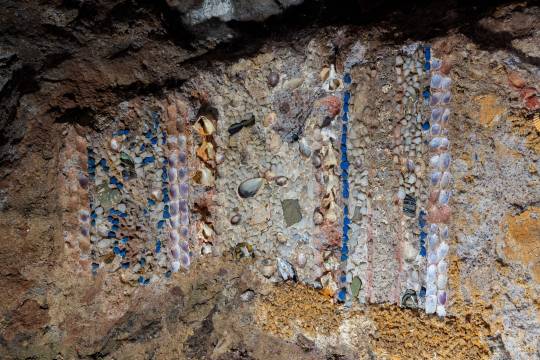

One mosaic depicts a coastal city with towers and porticos, with three large ships floating by on the ocean waves. The culture ministry believes this could be a reference to naval victories achieved by the owner of the home, which is believed to have been a Roman senator. This is supported by historical sources describing the area as having been occupied by such high-ranking members of society.
The decorated walls were likely located in the home’s dining rooms, where luxurious banquets would be hosted, and guests at these events were likely wowed with “spectacular water games,” according to the culture ministry, based on the presence of lead pipes set into the walls.
In the reception room, an extremely well preserved decorated stucco featuring landscapes and figures was also discovered. Other designs include vines and lotus leaves flowing from vases, musical instruments, and tridents.

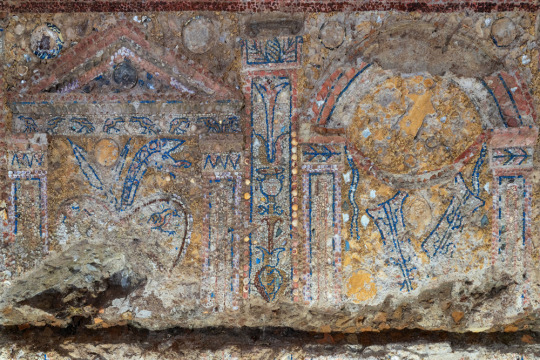

The mosaic walls were first discovered near the Colosseum in 2018, but excavation at the site will continue into 2024, and more rooms could be discovered. Alfonsina Russo, the Director of the Archaeological Park of the Colosseum, has said that once the domus is full uncovered, “we will work intensely to make this place, among the most evocative of ancient Rome, accessible to the public as soon as possible.”
By Verity Babbs.
#‘Incredible’ Mosaics Were Found in an Ancient Luxury Home in Rome#Archaeological Park of the Colosseum#Late Republican Age#second century B.C.E.#mosaic#roman mosaic#ancient artifacts#archeology#archeolgst#history#history news#ancient history#ancient culture#ancient civilizations#ancient rome#roman history#roman empire#roman art
1K notes
·
View notes
Text

~ Oval gem with bust of Io.
Culture: Greek or Roman
Period: Late Republican or Early Imperial Period
Date: 100 B.C.–A.D. 50
Medium: Glass
#ancient#ancient art#history#museum#archeology#ancient history#archaeology#greek#Roman#imperial Period#late republican period#glass#gem#bust of io#io#100 b.c#a.d. 50
1K notes
·
View notes
Text
WHY is emailing potential supervisors so intimidating. like hey esteemed academic in the field i aspire to become qualified in do you want to put up with my stupid fucking research project. do you want me to plague you with emails for the next year. do you want me to ruin your fucking life you poor innocent soul ensnared by your duties to inarticulate sleep deprived classics students. god
#like what the fuck do i even say#do i use his first and last name ??? do i call him professor ?????? do i say dear or is that too formal ?????#how do i explain my dissertation topic when i don't have an actual title or line of argument yet#maybe i'll just attach an image of a statue of caesar and be like “discuss”#FUCKKFKDJFLJ;ASF fuck#i'm so scared. he's written so many amazing papers on roman republican art and i've read like all of them#i didn't think he'd be my supervisor because he usually does phd stuff#but my lecturer was like nah email him he'll want to see your ideas#THAT MAKES IT FUCKING SCARIER I DON'T HAVE ANY IDEAS BROTHER#i haven't done enough reading yet to have formed my own opinion or argument#he's going to think i am a fucking idiot
8 notes
·
View notes
Text



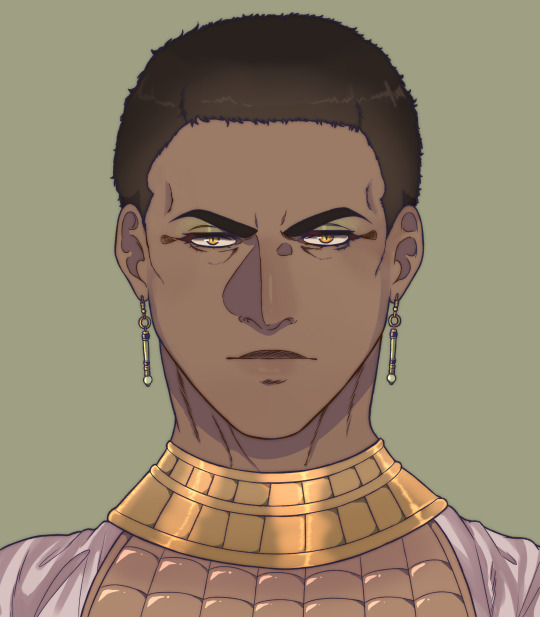

Introducing the main characters from the webcomic I'm developing on Ancient Egypt: Lucius, Djet, Iaret (Chloe), Khawy and Sempronia!
#webcomic#ancient history#pharaonic egypt#roman egypt#republican rome#imperial rome#ptolemaic egypt#new kingdom#late period#ancient egypt#ancient rome#vampires#my art#tfotds#the followers of the divine snake#smswart#thefollowersart#lucius#djet#iaret/chloe#khawy#sempronia
4 notes
·
View notes
Text
anyway more republican art posting but. the characterization of republican art and the notions of personal appearance in that period make it so interesting to me. i think pliny said this when i was reading him talking about the ancestral imagines but he basically characterizes a 'decline' of art from the republican era to his time, essentially with art becoming less about showing the individual characteristics and personality of a person and more iconographic/about projecting things like wealth or power rather than capturing individual features. essentially he says portraits became more of a 'stereotype' which signalled what kind of person you were, rather than a portrait of your particular face. which i think, although i don't really know how right pliny was about his own time obviously, is definitely something which characterizes republican art in the cursory glance at roman art history i've taken; ie the focus on capturing idiosyncratic and individual portraits of people (even to the point of possibly exaggerating them, almost like a caricature) in order to capture almost something about their soul. i think this is why i find that era of portrait busts so alluring, and though there are also definitely imperial era ones which have the same idea of capturing an individual, the republican ones hit different imo
#pliny nat.hist. 34.4- btw#it's really interesting that this style of portraiture seems to have evolved specifically out of the republican political milieu#which is why it's so unique in terms of ancient art because other societies with different governmental structures which didn't focus so#much on individual glory but also specifically building a family legacy out of individual glory (both separate and intertwined - the family#wouldn't get you to the end but it could start you off. you still had to make your own mark to get anywhere - you couldn't always just coas#off family connections)#so it's these aristocratic dynasties but a great amount of focus on the individuals within them and how they shaped up to their ancestors#and i think this general mindset created that art style (verism) and made it very. representative of the repulican zeitgeist#even outside of that political context . it echoes it. idk. the roman urge to say look at me. im an old man. im an important old man.#a particular old man. remember every wrinkle on my old man face. yeah
1 note
·
View note
Text
"Late Night with the Devil" is a horror movie releasing tomorrow about a 70's late night show that has been highly anticipated by the indie film scene.
That is, until reviewers discovered that 3 title cards during the movie were AI generated art. (I couldn't tell myself when I saw the images, but if you look closely enough the telltale signs are there.) Now the same people who were championing it, are boycotting it. I'm not kidding.
These are from the same community that if you ask about a movie by Roman Polanski, Woody Allen, or Harvey Weinstein, talk about "separating the art from the artist." I'm not calling them hypocrites - these are apples to oranges - but the scale of the difference is very funny.
I'm not a fan of AI art, at least in its current incarnation, which promises to replace quality, adequately paid art with industrial slop at a mass scale. I get drawing a line and trying to defend the line.
If anything, it reminds me of tumblr and fan fiction communities. The way the sharpest knives in identity politics aren't out for Republicans and white men and grey tribers - no these days they are wielded against authors who have five intersectional flags but offend against a sixth. Because you can't hurt the mega-establishment, but you can hurt the queer POC author next door.
Which just makes the insular progressive communities hellscapes without proportionality.
No enemies but the in-in-in-in-in-group.
155 notes
·
View notes
Text

Seems familiar?
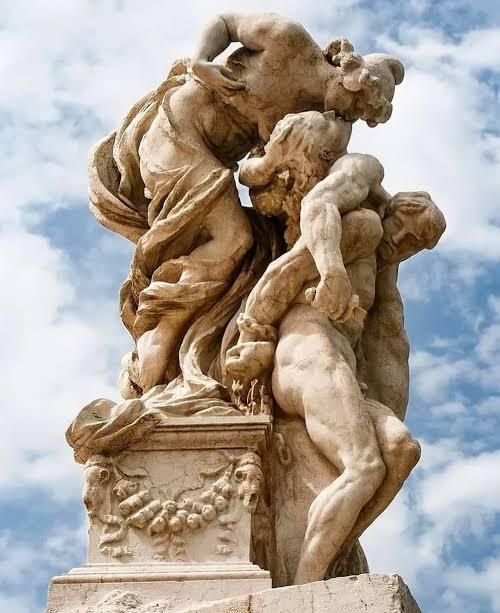

This sculpture group called Sacrifice by Leonardo Bistolfi (1911) and the picture above is a part of it. Here is what I have found about the art.
"The “Sacrifice” group, however, is made up of four allegorical figures: a slave, about to be freed from the chains that still hold him back, supports a dying brother in arms – the man of the Risorgimento, captured in his extreme, heroic act of sacrifice – as he receives a final kiss from the Genius of Freedom, a woman wearing a Phrygian cap, sitting on a Roman altar. The Family, represented by another female figure, helps hold the dying hero."
Phrygian cap: It is used in the coat of arms of certain republics or of republican state institutions in the place where otherwise a crown would be used (in the heraldry of monarchies). It thus came to be identified as a symbol of republican government.
"The work is carried by the brother of a hero who died in the events of the unification of Italy. It describes how he was sent off with the last kiss by his wife on the Roman altar."
"The Sacrifice is a soldier who, despite being close to death, continues to aspire to liberty. "

And we have this.
We have four figures, Simon, Wille, Erik and Kristina.
Wille is finally sending off his dead brother. I think it is in more than one sense. One: he is saying goodbye to his brother, who was a hero to him and maybe Simon is the one who opened his eyes with his comment. People aren’t perfect, and that includes siblings too.
That's the sacrifice Wille makes. Letting go of his perfect brother and with that, there comes my second point, he is saying goodbye to the monarchy as well because that was the only thread Wille was hanging on, trying to be the Crown Prince, to honor Erik. Monarchy keeps them chained and makes them slaves and it is not acceptable to live like that.
I believe the promo pic might be a shoutout to this sculpture. However, the positions in the sculpture and the photo is quite the opposite. On the left, we have the female figure and on the right, we have the brother. But with Wilmon, it is is vice versa. Maybe I am reaching here but that may be about breaking the traditions as well. So a different angle and breaking the norm is what we go with.
In one of the sources, it says the art depicts "the final kiss between The Genius of Liberty and a young soldier who is about to die." but i am not concerned about it. I think the Crown Prince Wille will be gone and we will have free Wille at the end.
It all screams abdication to me.
110 notes
·
View notes
Text
Notes on Roman architecture:
Roman architecture was influenced by local geography, class dynamics, and imperialism. The extensive use of concrete reflects central Italy's abundance of concrete ingredients (limestone and tufa), as well as Rome's dependence on slave laborers who usually weren't trained stonemasons. The oval shape of Roman amphitheaters comes from the original layout of the Roman forum where temporary wooden amphitheaters had to fit the available space.
Roman architecture was most heavily influenced by Greek and Etruscan culture. In fact, Roman generals would steal artifacts wholesale to display in their own temples, houses, and monuments. This was not considered an implicit admission of the superiority of Greek and Etruscan arts, but a demonstration of Rome's military prowess and piety: "This is ours now. And we're using it to honor our gods."
Extra shout-out to Lucius Mummius, who may have installed Rome's first temple with Corinthian columns...to commemorate burning down Corinth.
Aristocratic competition produced most of Rome's monuments in republican times. A statue, arch, column or temple not only glorified an individual's career, but gave publicity for his family and descendants as well, hopefully giving them an advantage in elections. In the last decades of the republic, and imperial times, we see more tombs and gravestones dedicated by ordinary people as well.
A few particularly Roman features: arches used more prominently and in more formal contexts than in Greece; oval amphitheaters with low stages and seating arranged by social class; the grid-like layout of planned Roman colonies; and higher podiums for (most) Roman temples than Greek ones, with more stairs and deeper porticoes, to protect augers from inclement weather while watching for signs.
Occasionally, Roman leaders would also commemorate their successes through building aqueducts or roads (like the Via Appia and Aqua Julia), but this was less glamorous.
Maintaining all these monuments (and aqueducts, roads, sewers) was also not very glamorous, and bloody expensive, so sometimes they fell into disrepair. This only really started to shift when Augustus sought to rebuild the city's image, literally and figuratively, so he "encouraged" generals and politicians to put more work into that.
Republican Rome was extremely vulnerable to fire, being primarily made out of wood, with many insulae (apartment buildings) packed close together. It wasn't until the Great Fire of Rome in Nero's reign that building codes would be created to mitigate this.
Country villas were much fancier than houses in Rome itself. In the city, private luxury came with the risk of public censure, and most aristocrats (outside the Palatine) lived right next to insulae and middle-class dwellings. So there was an incentive to display one's wealth through public works instead of by making the fanciest house you could, under your neighbors' envious eyes.
(Not that this stopped people like Pompey or Lucullus.)
From Katherine E. Welch, "Art and Architecture in the Roman Republic," in A Companion to the Roman Republic, eds. Nathan Rosenstein and Robert Morstein-Marx.
#jlrrt essays#jlrrt reads#katherine welch#art and architecture in the roman republic#a companion to the roman republic#architecture
54 notes
·
View notes
Text
coke capitalism in 3x06 “what it takes”
in the evening, after the candidates’ dinner, logan calls the establishment candidate dave boyer, inviting him to meet and asking if he’ll “run [him] over a coke.” on a superficial level, this is a simple fuck-you: assigning a bitch-boy task to the man who needs logan’s support in order to become the next president. however, the choice of coke specifically is highly significant to the episode’s political commentary.
coca-cola’s brand image is deeply linked to the american empire (’cocacolonization’) and a rosy, propagandised image of capitalism in general. when logan asks boyer for a coke, we can read this as symbolic of the relationship he wants waystar and potus to have. the president should run errands for logan roy, specifically in a way that subordinates the political office and the state to waystar’s economic needs and the economy in general.
this is an inversion of older forms of capitalism, like 18th-century court capitalism, wherein corporations were allowed to exist and granted economic privileges only insofar as they served the interests of the state / sovereign. waystar has some value to the american empire, insofar as it exports soft power globally and manufactures consent domestically. but the balance of the relationship between logan and potus clearly tilts in logan’s favour multiple times throughout the show, and demanding the coke is essentially logan telling boyer he expects this arrangement to continue, literally asking the president to bring him american capitalism for his own consumption.
meanwhile, roman meets with mencken in logan’s bathroom (the gold accents in the bathroom, in combination with the coca-cola, also evoke a certain trumpian quality in logan). while mencken denies being a “dancing monkey,” roman understands that atn’s goal is to peddle whatever sells—in this case, fascism, which is particularly well-suited to spectacle and therefore to tv.
thus, when mencken brings logan a coke after all, he’s conveying two messages. one, that he’s willing to ‘play nice’ with logan. two, that his brand of fascist spectacle will actually do a better job than establishment republicanism of encoding american politics as flows of pure capital. analogously to the eminently consumable soda, this arrangement will melt down all political meaning and transform it into brute monetary value that waystar can use.
by kissing the coke, however, mencken makes it impossible for logan to actually drink it: it’s now been tainted, both by literal germs and by homoeroticism. this is where roman’s role is critical. unlike logan, roman is openly aroused by fascist masculinity, hence his literal flirting with fascism in the bathroom. roman is able to consume the coke, taking a political-economic waste product into his body and ‘consummating’ the deal logan has just made. roman’s body thus serves as both a waste receptacle and a symbolic representation of how american capitalism ‘gets into bed’ with fascism.
on a meta level, the choice of coke is also quite funny because we can presume that coca-cola paid for that product placement, or at least permitted it. despite the fact that the scene and the show have plenty of unflattering things to say about capitalism and fascism, the value of product placement on a popular tv show will always trump any critique being made within the show itself. capitalism is capable of absorbing any criticism of itself simply by selling it: in this case, ‘tv show’ is both an art form and a commodity, and no radical critique internal to the text is capable of altering the underlying economic relation.
187 notes
·
View notes
Photo

The Ides of March. On March 15,44 BC, Julius Caesar was assassinated.
We owe Julius Caesar the famous phrase “the die is cast” (Alea iacta est). He said this in January 49 BC when he led his army across the Rubicon River in northern Italy, after his conquest of Gaul. A positive aspect of him is that he did not seek revenge. He spared the lives of his enemies defeated in the civil war with the intention of turning them into friends and together improving what he called "the new Republic." Among his murderers on that Ides of March were those "friends" whose lives he had spared.
In 59 BC he founded Florentia which later changed its name in Italian to Firenze (Florence). The curious, almost prophetic thing is that Florentia in Latin means “flowering” and it was in Florence where emerged the cultural movement known as the Renaissance (a flowering of art of the Ancient Rome).
In 46 BC he modified the Roman calendar, creating the novelty that the year began on January 1 and not March 1 as in the previous calendar in addition to the novelty of the leap year.
Julius Caesar, one of the most famous men, had a passionate relationship with one of the most famous women, the Ptolemaic Egyptian queen Cleopatra VII. They had a son, named Caesarion. After Cleopatra's arrival in Rome in the year 46, Caesar himself officially recognized the child as his son.
He had a daughter named Julia, whom Caesar married to Pompey Magnus, who would later be his greatest rival and whom he defeated during the civil war at the Battle of Pharsalia. Julia and the baby died during childbirth. Caesar adopted his grandnephew, Octavian as his son and sole heir. Years later, Octavian ordered the execution of young Caesarion, days after Cleopatra committed suicide.
Caesar proclaimed himself Dictator for 10 years, something completely unusual. The position of Dictator was an occasion in which a man was elected by the Senate for a period of 6 months to 1 year to make special laws, in times of war or serious crisis. In addition to the calendar,Julius Caesar has also forever changed the meaning of being a Dictator.

He became a dictator in the modern sense of the word: he was populist, he did things to please the Roman people to the point that they idolized him. Although it must be recognized that he did very favorable things for the people.
Shortly after, he proclaimed himself Dictator for life, this sealed his tragic end.
Senators agreed to assassinate him.The conspiracy was carried out in the house of Servilia ,mother of Brutus and lover of Julius Caesar for years.
They stabbed him 23 times, taking him by surprise in the Senate.
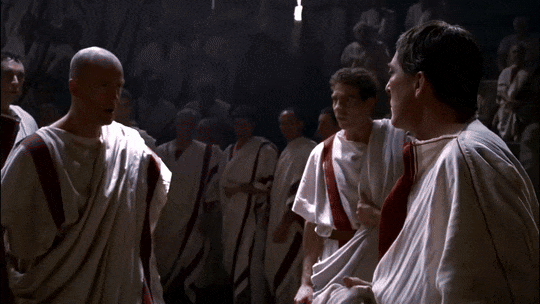
After years of civil war caused by this assassination, his grandnephew Octavian,Caesar Augustus, became the first Emperor of Rome. Unlike his uncle and adoptive father, Octavian was very vengeful; Within a few years, all of Caesar's adversaries and assassins were dead.
Historians agree that with exceptions, such as Cato, Cicero, Brutus or Cassius,who sincerely believed that the Republic was in danger, the others did not decide to assassinate him out of fear of a monarchy, as they hypocritically claimed, but out of envy and ambition; They did not want to be republicans, they wanted to be JULIUS CAESAR, the same desire of every authoritarian ruler from then to the present.
349 notes
·
View notes
Text
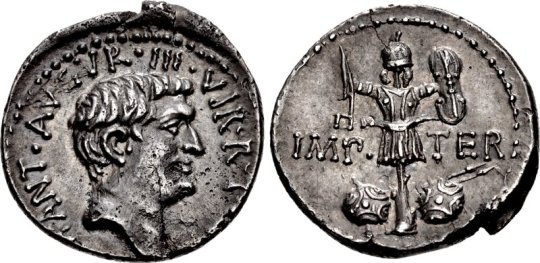
Denarius of the famous Roman general and statesman Mark Antony (Marcus Antonius), born 14 January 83 BCE. This coin was minted in the late summer or autumn of 38 BCE, possibly to advertise the renewal of the triumvirate between Antony, Octavian, and Lepidus in that year. At the time of its issue, Antony was preparing, with Cleopatra's help, for a campaign against the Parthian Empire (which would, in the event, end in disaster, severely weakening his position and setting the stage for his final showdown with Octavian). The obverse of the coin bears the bust of Antony, who is identified as AUGUR (an important Roman priesthood, responsible for taking the auspices by observing the flight of birds) and TRESVIR R(EI) P(UBLICAE) C(ONSTITUENDAE) (the official title of the members of the triumvirate). The reverse, in a testimony to Antony's past glories and future ambitions, labels him IMPER(ATOR) TER(TIUS) ("thrice acclaimed victor") and bears a trophy (tropaeum), an empty suit of armor erected to mark the point at which the enemy army began to flee.
Photo credit: Classical Numismatic Group, Inc. http://www.cngcoins.com
#classics#tagamemnon#Ancient Rome#Roman Republic#history#ancient history#Roman history#Mark Antony#Marcus Antonius#art#art history#ancient art#Roman art#Ancient Roman art#Roman Republican art#artifact#coins#ancient coins#Roman coins#Ancient Roman coins#denarius#numismatics#ancient numismatics#Roman numismatics
125 notes
·
View notes
Photo
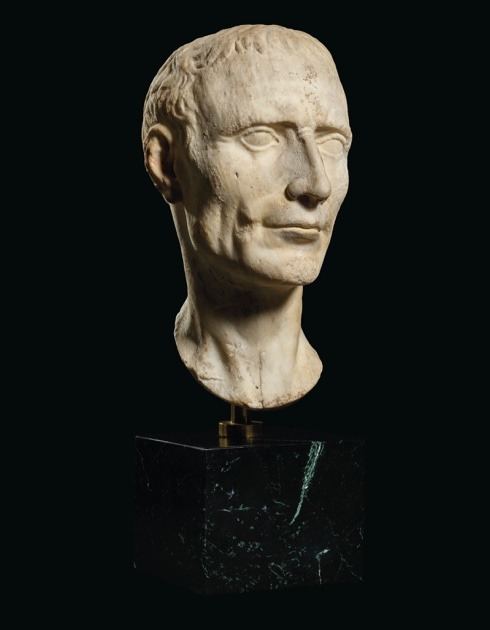
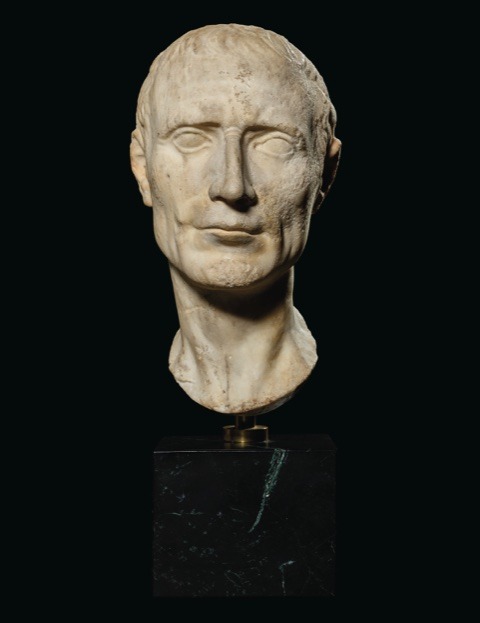

A ROMAN MARBLE PORTRAIT HEAD OF A MAN
REPUBLICAN PERIOD, CIRCA LATE 1ST CENTURY B.C.
11 7/16 in. (29 cm.) high
In a letter to the previous owner from 1991, Cornelius C. Vermeule wrote: "This Republican head does look like Julius Caesar, but is probably someone else of his era, like the head restored on the Barberini togatus of the man holding the busts of his two ancestors. There was also a great vogue for reviving Republican portraiture in the late First and early Second centuries A.D., and Republican lookalikes, such as Hadrian's brother-in-law L. Julius Ursus Servianus."
As Vermeule notes, this example's likeness to Julius Caesar is striking, particularly to a bust of the dictator known as the "Chiaramonti-Pisa Type," now in the Vatican Museum (see F.S. Johansen, "The Portraits of Marble of Gaius Julius Caesar: A Review," fig. 1a). As he goes on to explain however, it was common practice beginning in the Republican era to commission private likeness after prominent public figures and likely this is what we have here. In his extensive study, Johansen writes that he believes only two actual representations of Caesar himself exist in marble, the first being the aforementioned example, and the other being a bust thought to be commissioned in his lifetime, known as the "Tusculum type" (see figs. 1a and 15a, op. cit.). Nevertheless, the present example illustrates that while the veristic style was certainly in vogue with reference to Republican portraiture, it did not prohibit artists nor their patrons from using other people's likenesses as inspiration.
#A ROMAN MARBLE PORTRAIT HEAD OF A MAN#REPUBLICAN PERIOD CIRCA LATE 1ST CENTURY B.C.#marble#marble statue#marble bust#ancient artifacts#archeology#archeolgst#history#history news#ancient history#ancient culture#ancient civilizations#ancient rome#roman history#roman empire#roman art
29 notes
·
View notes
Text
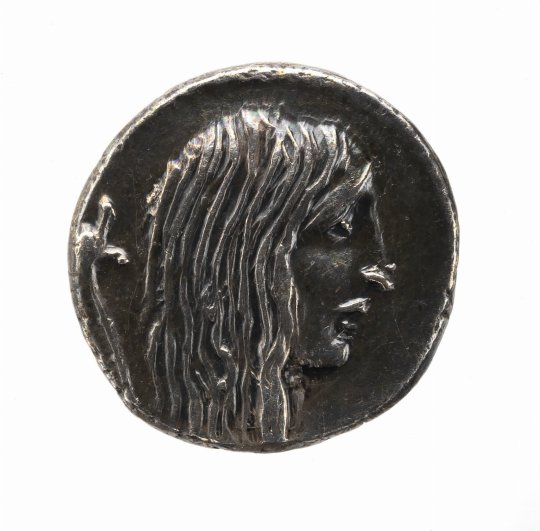

~ Denarius.
Place oforigin: Rome, Italy
Maker: Lucius Hostilius Saserna
Period: Republican Roman Period
Date: 48 B.C.
#ancient#ancient art#history#museum#archeology#archaeology#ancient currency#currency#denarius#long hair#diana#spear#stag#rome#roman empire#ancient roman#republican period#Lucius Hostilius Saserna#48 b.c.
527 notes
·
View notes
Text
How I once almost started my Heresy-obsession as a gigantic Ultramarines fan
When I was thinking about something @varanguard tagged me in, I ended up in a roundabout way where the obsession with the Horus Heresy started for me.
Buckle up, dear children, story time!
Back then, I was a big fan of the Space Wolves - something that continued for a long time. I've since known to have moved on from them, as the content for them really leaves a lot to be desired in terms of quantity and quality. Poor blokes.
But at the time, I was all about Ragnar Blackmane and his absolutely crazy, silly, sometimes very juvenile adventures.
And then came my friend M., my partner in crime when it came to history geekery. With whom I hiked the raetian Limes, with whom I talked my head off all night about the War of the Federates and the background to Roman electoral law. With whom I wandered around the underground of the ancient Roman neighbourhoods in Trento and with whom I waved my arms in sheer delight as I looked at the Mythraum in the Saalburg and raved about the torsion weapons on display there.
And he acted all innocent and asked: "What if there was a legion in the Heresy where we could discuss the influence of Dionysus cults from southern Italy on politics and culture in a very abstract way? I mean, look at Syracuse …."
He had me there. Subtly slipped me the parallels, grabbed me by my fascination for niche events, especially in the art historical sense.
I mean, you can easily see the Maraviglia on the wall of the Villa of Mysteries in Pompeii. The house of a very internationally active olive oil merchant who had contacts around the Mediterranean (as can be seen from the seals on the amphorae) and who had no problem putting bacchanalian scenes in the most garish colours on his walls.
From there it was a short way to the Greek cult of the hero and in the other direction to the worship of the solitary genius in the Renaissance.
Genesis of an Emperor's Children fan. Put me in a shell and wash me ashore at Cyprus.
And here it could as well have been blue instead of purple. Because I'm actually more fascinated by the Roman late republican period than the imperial era. I actually enjoy the political entanglements of the Equites more than their decline under the emperors.
As much as I was interested in the turmoil and conflicts of loyalty from the second century onwards, the reforms of Marius are more exciting in my opinion.
Virtutes and their interpretation? My thing! The organisation of public life? Wow, that's great!
Sounds more like ultramarines. I'd say that today.
But he didn't like them. For whatever reason. So he turned me in the direction he thought would be more interesting for me and let me run off - well fed with bait.
And of course, the Emperor's Children were right up my alley! In terms of art and military history as well as philosophically.
But still: @ladymirdan and I could almost, yes almost, have even better lore boxing matches today! It was very close! If he hadn't had that irrational but very typical "Ultramarines are boring" attitude. So it became Florence instead of Rome. The rest is history.
Thanks to everyone who has stuck it out this far. Text structure is not my strong point!
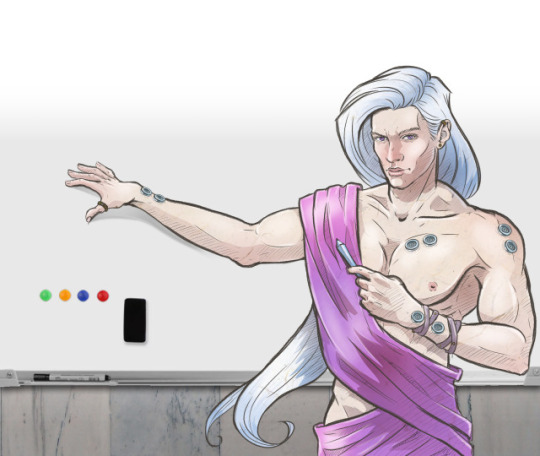
34 notes
·
View notes
Text
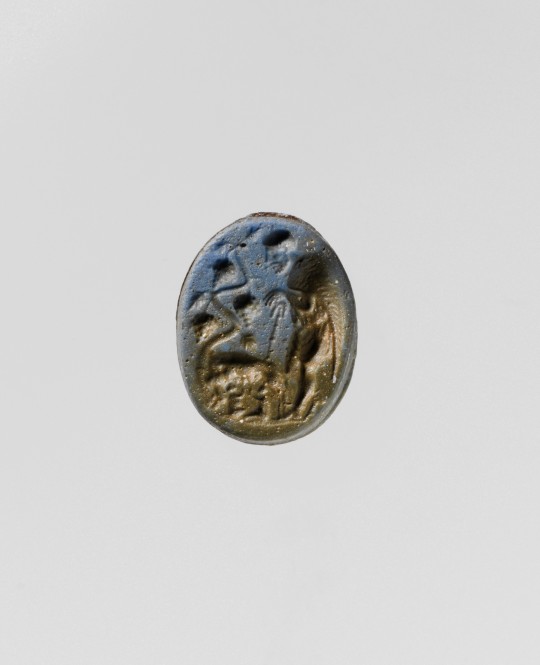
Opaque blue glass oval engraved gem. Roman 1st century BCE. x
According to tradition, Rome was founded in 753 B.C. by the twins Romulus and Remus. Sons of the god Mars and a mortal woman named Rhea Silvia, a direct descendant of Aeneas, the twins were abandoned by their uncle in the Tibur river. A she-wolf discovered them on the banks of the river and suckled them until they were taken in by a passing sheperd, Faustulus. Faustulus raised the boys together with his own twelve children until they decided to found a city of their own. They chose the spot by the Tibur where they had been rescued by the wolf, which was near the base of the Palatine hill in Rome. The representation of the wolf suckling the twins became a popular subject in Roman Republican and Imperial art. Here the sheperd Faustulus leans on his staff and watches the Roman she-wolf suckling the twins under a vine.
12 notes
·
View notes